1.MONOCHROMATIC COLORATION . The image is portrayed in variable diffuse tones of a pale brownish-yellow color (consistent with a puce color, sepia toned). The intensity of the image shows what we call the half-tone effect and is caused by the amount of discolored fibers per square unit. The image also appears more distinct at a distance and fades out when viewed at different angles, particularly as one comes close to the Shroud.
2.The image displays the light and dark characteristics that you normally observe in a PHOTOGRAPHIC NEGATIVE and that was discovered in 1898 when Secondo Pia made the first photographs of the Shroud. After developing his negative glass plates, he found to his surprise that they showed a positive image of the Man on the Shroud. This light/dark and left/right reversal has not been seen in Art before the discovery of photography in the 19th century.
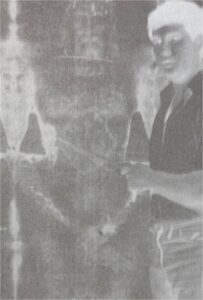
Photographic negative Shroud |
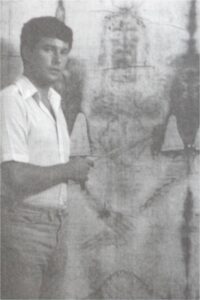
Photographic positive Shroud |
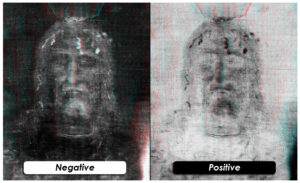 Photographic positive and negative face
Photographic positive and negative face
3. SUPERFICIALITY. The image is present only on the top two or three fibers of the threads. These fibers are hollow, and the lumen is called medulla and shows no discoloration, and the individual fibers are all about the same color (monochromatic). It is important to note that these individual fibers of the threads are 10 to 20 times thinner than a human hair (14-8 micrometer for every fiber = 0.25-0.3 mm). Every yarn is composed of 70-120 linen fibers each 0.25-0.3 mm. According to Kevin Moran, on the sides of the fibers the image is like cut with a knife, visible with precision microscopy, so no image on the backside of the fibers.
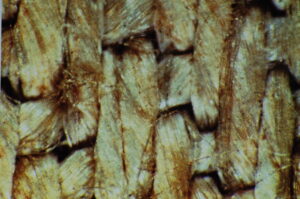
Shroud weave with image |
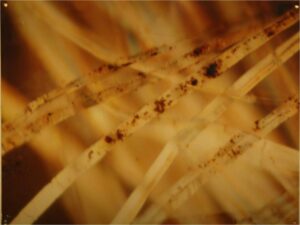
Individual fibers |
4.NO DIRECCIONALITY. In a photograph one can observe a directionality, which means that you can see from which direction the light came that caused the shadows and light areas. The image on the Shroud does not show this characteristic and it seems that the image was formed straight up- and down, which is called “COLLIMATED”. There is also an absence of brushstrokes.
5.X-RAY PROPERTIES. While studying the image on the ENRIE photographs, Prof Alan Whanger observed that in the face the sinuses were visible and also part of the teeth. In the image of the hands, the metacarpalia are visible like on an X-Ray photograph. It seems that part of the “energy” that caused the image had long wavelength X-Ray properties.
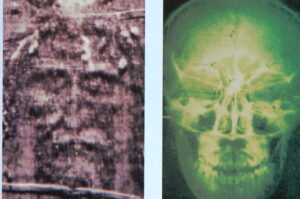
X -ray properties face |
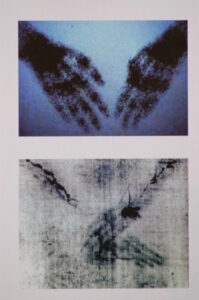
X- ray properties hands |
6.NO OUTLINES. The image does not show any outlines and fades away in the surrounding Shroud. Artists normally use outlines when drawing an image of a person. In a photograph the outlines are also clearly visible.
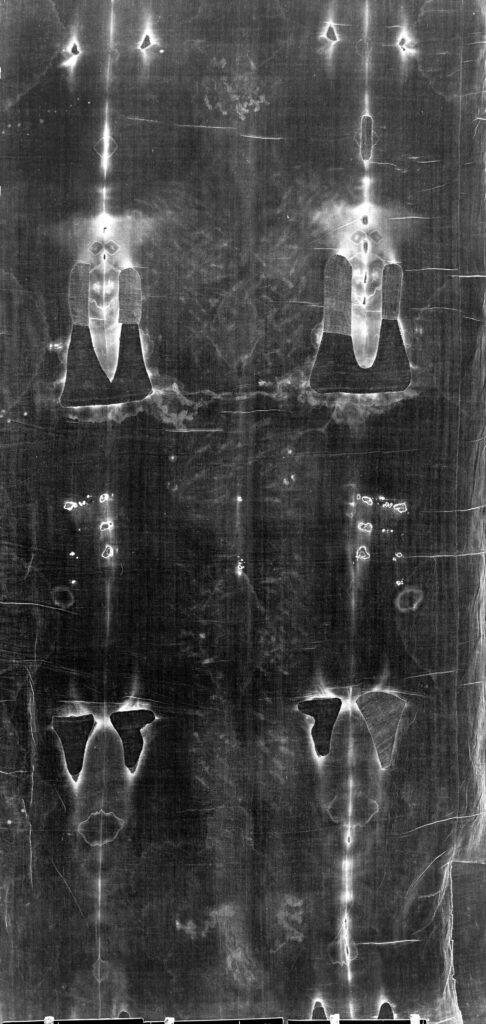
Dorsal view |
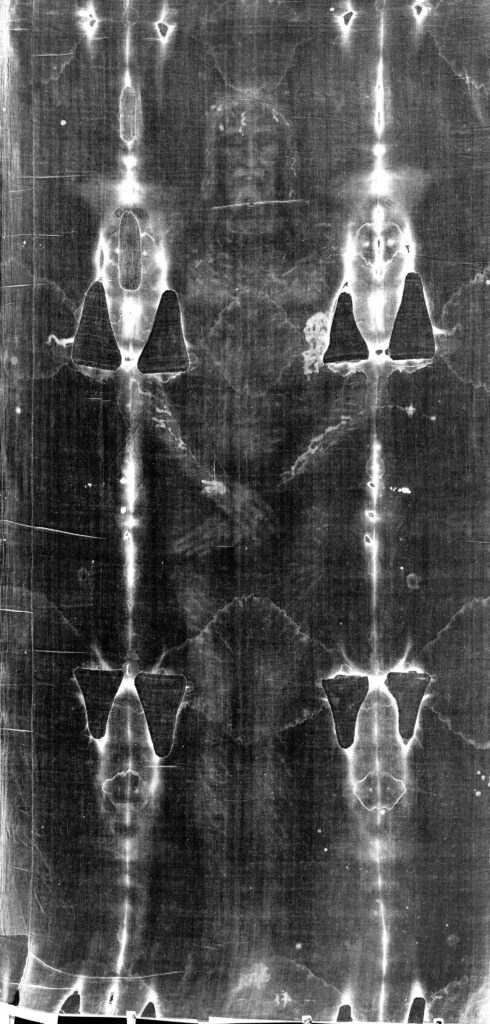
Ventral view |
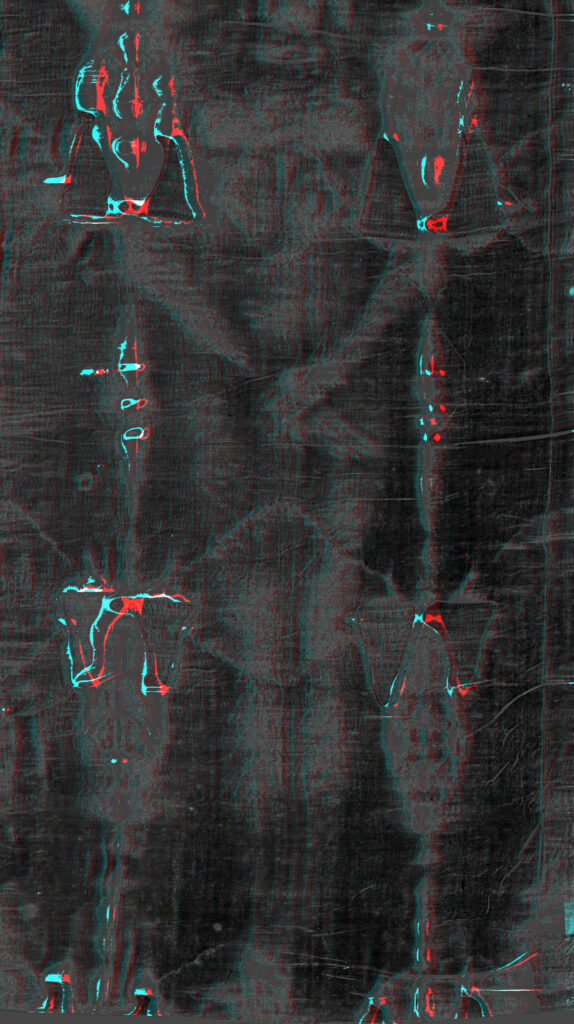
Ventral view (ANAGLYPH 3D GLASSES)
7.ANATOMICALLY CORRECT. The image of the Man on the Shroud is anatomically correct. There is foreshortening of the legs caused by the bending of the two legs. If the image formation was collimated, then that makes sense of course. The fact of the anatomical correctness excludes a process of image-formation by direct contact.
8. IMAGELESS AREAS. Research has shown that there is no underlying image present under the blood spots, showing that the blood was present prior to the formation of the body-image. Another part where there is no image present is on the sides of the face. Botanist Avinoam Danin found there the presence of flowers (Anthemis) and concluded that these flowers had blocked the image formation of the underlying anatomical structure. So it strongly suggests that the “radiation” (?) did not penetrate solid objects like the blood, flowers and the solid oval object under the beard.
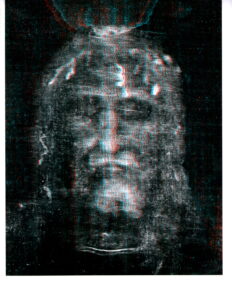
Imageless areas sides of face
9. STABILITY. The image on the fibers shows a relative stability when subjected to heat, water and some chemicals.
10. SERUM RETRACTION RING. Under Ultra-Violet Fluorescent Photography, almost all the blood (scientific research has proven that it is human blood) shows a serum retraction ring of albumin around the solid parts of the blood, typical for post-mortem blood. This phenomenon is not visible with the naked eye and was unknown until about 100 years ago. Also, there is no fluorescence in the image areas, but the scorch areas, (caused by the 1532 Chambery fire), do show fluorescence.
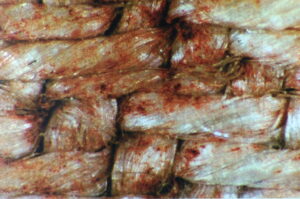
Bloodspot |
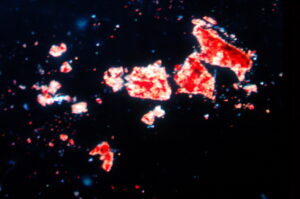
Blood under microscope |
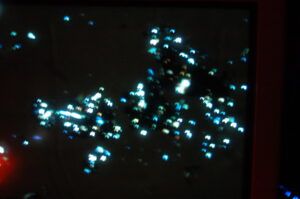
Blood colored by UV light
11. CHEMICAL PROCESS. When the image fibers were subjected to scientific testing, the resulting findings were, that the image was caused by a chemical process of oxidation, dehydration and conjugation of the polysaccharide component of the cellulose of the flax fibers. This is the same process that occurs in the normal aging of linen fibers, but is extreme in the image, compared with the fibers in the non-image areas.
12. 3D INFORMATION. An encoding of 3D information is present in the grayscale of the image which was shown in 1977 by Jackson & Jumper with the VP8 Image Analyzer. This 3D information was not present in photos and paintings, all of which showed distortion with flattening of the relief, including the arms within the abdomen and the nose pressed in the face.
The image on the Shroud varies inversely with the cloth-to-body-distance. This means that the darker the image the closer this part of the body was to the Shroud and the lighter the image the further away these parts of the body were from the Shroud when the image-processing occurred. This means that every pixel in the gray-scale of the Shroud-image carries a cloth-to-body-distance relationship. This particular quality was used to create the Holograms of the Shroud-image.
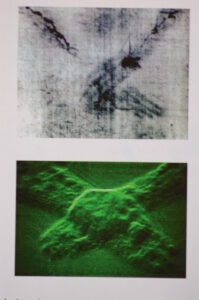
Hands in 3D in VP8 Image Analyzer
13. ALDO GUERRESCHI, a professional photographer, in April 1997 following the dramatic fire in the Turin Cathedral, was asked to document the following examination of the Shroud. He observed the following: “ Moving around the table, with the Shroud unrolled horizontally, I saw from a certain angle this image so faded as if to practically disappear, While from other angles it seemed as if the figure was almost outside the sheet “. There was a light source coming from one side from high windows. This is a very holographic observation.
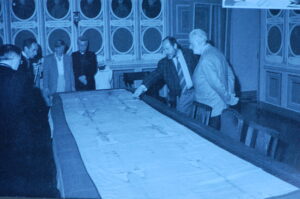
After fire 1997
14. LORRE and LYN (1978 STURP) analyzed the back image of the Shroud with IBM 360/65 and reported a purely random, unexplainable distribution of straight- line forms with no directionality. They also analyzed the scourge marks by creating a type of relief gradient using their IBM 360/65. Their research suggests that there were two directions, suggesting two different Roman soldiers, on opposite sides of the victim (or one soldier changing from one side to the other).
15. No ADHAESION of the fibers in the image and no IMPREGNATION in the fibers.
There have been several attempts to reproduce the image on the Shroud. It is clear, that the results of the processes involved should show ALL the 14 before mentioned characteristics of the Shroud image, not just 3, 7 or 9 of these image qualities. Every technique used to reproduce this image and that does not produce all these characteristics, is a different process then the image-formation process that produced the image on the Shroud itself. Recently there was another attempt by Prof. Garlaschelli in Italy to show that with existing techniques in the 11th and 12th century the image could have been produced. Prof. Garlaschelli cannot answer questions on several of the characteristics that we mentioned before. (see next article for my response to Garlaschelli in 2002).
Click to see article for my response to Garlaschelli in 2002
*To return close tab
